Surface Properties of Coatings Based on Iron Amino-Functionalized Oxides Deposited on DH 36 Steel Plates for Shipbuilding
Abstract
1. Introduction
2. Materials and Methods
2.1. Materials and Paint Formulation Synthetic Procedures
2.2. Chemical Characterization
2.3. Physical/Mechanical Characterization
2.4. Microtox Assay
2.5. Bacteria, Culture Conditions, and Microbiological Tests
3. Results and Discussion
4. Conclusions
- SiO2-NH2-Fe powders exhibited better antibacterial performance compared to TiO2-NH2-Fe powders, making SiO2-NH2-Fe a more suitable candidate for antifouling applications;
- The higher adhesion and lower surface roughness exhibited by the SiO2-based material compared to the TiO2-based material, together with its hydrophobicity (θ > 90°), further support its potential to improve the durability and performance of coatings in marine environments;
- The application of a primer coating followed by a tie coat containing TiO2-NH2-Fe or SiO2-NH2-Fe powders on DH 36 steel plates eliminates the need for an additional topcoat, presenting a notable strategic advantage for simplifying the coating process while maintaining effective steel surface protection.
Author Contributions
Funding
Data Availability Statement
Acknowledgments
Conflicts of Interest
References
- Akhter, P.; Arshad, A.; Hussain, M. A review on environmental impacts of paints and strategies for producing eco-friendly-paints. Int. J. Environ. Sci. Technol. 2025, 22, 555. [Google Scholar] [CrossRef]
- Fanicchia, F.; Karlsdottir, S.N. Research and Development on Coatings and Paints for Geothermal Environments: A Review. Adv. Mater. Technol. 2023, 8, 2202031. [Google Scholar] [CrossRef]
- Faccini, M.; Bautista, L.; Soldi, L.; Escobar, A.M.; Altavilla, M.; Calvet, M.; Domènech, A.; Domínguez, E. Environmentally Friendly Anticorrosive Polymeric Coatings. Appl. Sci. 2021, 11, 3446. [Google Scholar] [CrossRef]
- Zhao, W.; Feng, G.; Zhang, M.; Ren, H.; Sinsabvarodom, C. Effect of low temperature on fatigue crack propagation rates of DH36 steel and its butt weld. Ocean. Eng. 2020, 196, 106803. [Google Scholar] [CrossRef]
- Dashtizadeh, A.; Abdouss, M.; Mahdavi, H.; Khorassani, M. Acrylic coatings exhibiting improved hardness, solvent resistance and glossiness by using silica nano-composites. Appl. Surf. Sci. 2011, 257, 2118–2125. [Google Scholar] [CrossRef]
- Shi, X.; Nguyen, T.A.; Suo, Z.; Liu, Y.; Avci, R. Effect of nanoparticles on the anticorrosion and mechanical properties of epoxy coating. Surf. Coat. Technol. 2009, 204, 237–245. [Google Scholar] [CrossRef]
- Phanasgaonkar, A.; Raja, V.S. Influence of curing temperature, silica nanoparticles- and cerium on surface morphology and corrosion behaviour of hybrid silane coatings on mild steel. Surf. Coat. Technol. 2009, 203, 2260–2271. [Google Scholar] [CrossRef]
- Jalili, M.M.; Moradian, S.; Dastmalchian, H.; Karbasi, A. Investigating the variations in properties of 2-pack polyurethane clear coat through separate incorporation of hydrophilic and hydrophobic nano-silica. Prog. Org. Coat. 2007, 59, 81–87. [Google Scholar] [CrossRef]
- Amerio, E.; Fabbri, P.; Malucelli, G.; Messori, M.; Sangermano, M.; Taurino, R. Scratch resistance of nano-silica reinforced acrylic coatings. Prog. Org. Coat. 2008, 62, 129–133. [Google Scholar] [CrossRef]
- Sangermano, M.; Malucelli, G.; Amerio, E.; Priola, A.; Billi, E.; Rizza, G. Photopolymerization of epoxy coatings containing silica nanoparticles. Prog. Org. Coat. 2005, 54, 134–138. [Google Scholar] [CrossRef]
- Barna, E.; Bommer, B.; Kürsteiner, J.; Vital, A.; Trzebiatowski, O.v.; Koch, W.; Schmid, B.; Graule, T. Innovative, scratch proof nanocomposites for clear coatings. Compos. Part A Appl. Sci. Manuf. 2005, 36, 473–480. [Google Scholar] [CrossRef]
- Chen, M.C.; Koh, P.W.; Ponnusamy, V.K.; Lee, S.L. Titanium dioxide and other nanomaterials based antimicrobial additives in functional paints and coatings: Review. Prog. Org. Coat. 2022, 163, 106660. [Google Scholar] [CrossRef]
- Scolaro, C.; Liotta, L.F.; Calabrese, C.; Marcì, G.; Visco, A. Adhesive and Rheological Features of Ecofriendly Coatings with Antifouling Properties. Polymers 2023, 15, 2456. [Google Scholar] [CrossRef] [PubMed]
- Scurria, A.; Scolaro, C.; Sfameni, S.; Di Carlo, G.; Pagliaro, M.; Visco, A.; Ciriminna, R. Towards AquaSun practical utilization: Strong adhesion and lack of ecotoxicity of solar-driven antifouling sol-gel coating. Prog. Org. Coat. 2022, 165, 106771. [Google Scholar] [CrossRef]
- Seraj, S.; Mohammadi, T.; Tofighy, M.A. 15-Polymer nanocomposite films and coatings for antifouling applications. In Polymer Nanocomposite Films and Coatings; Pandey, M., Deshmukh, K., Hussain, C.M., Eds.; Woodhead Publishing: Cambridge, UK, 2024; pp. 525–558. [Google Scholar]
- Padmavathi, A.R.; Murthy, P.S.; Das, A.; Veeramani, P.; Rao, T.S. Inorganic nanoparticle embedded Polydimethyl siloxane nanocomposites for biofouling mitigation. Surf. Interfaces 2021, 25, 101171. [Google Scholar] [CrossRef]
- Hu, P.; Xie, Q.; Ma, C.; Zhang, G. Silicone-Based Fouling-Release Coatings for Marine Antifouling. Langmuir 2020, 36, 2170–2183. [Google Scholar] [CrossRef]
- Liang, H.; Shi, X.; Li, Y. Technologies in Marine Antifouling and Anti-Corrosion Coatings: A Comprehensive Review. Coatings 2024, 14, 1487. [Google Scholar] [CrossRef]
- Calabrese, C.; La Parola, V.; Testa, M.L.; Liotta, L.F. Antifouling and antimicrobial activity of Ag, Cu and Fe nanoparticles supported on silica and titania. Inorganica Chim. Acta 2022, 529, 120636. [Google Scholar] [CrossRef]
- Izzi, M.; Sportelli, M.C.; Torsi, L.; Picca, R.A.; Cioffi, N. Synthesis and Antimicrobial Applications of ZnO Nanostructures: A Review. ACS Appl. Nano Mater. 2023, 6, 10881–10902. [Google Scholar] [CrossRef]
- Chekini, M.; Krivoshapkina, E.; Shkodenko, L.; Koshel, E.; Shestovskaya, M.; Dukhinova, M.; Kheiri, S.; Khuu, N.; Kumacheva, E. Nanocolloidal Hydrogel with Sensing and Antibacterial Activities Governed by Iron Ion Sequestration. Chem. Mater. 2020, 32, 10066–10075. [Google Scholar] [CrossRef]
- Sun, H.-Q.; Lu, X.-M.; Gao, P.-J. The exploration of the antibacterial mechanism of Fe3+ against bacteria. Braz. J. Microbiol. 2011, 42, 410–414. [Google Scholar] [CrossRef]
- Pansuriya, P.B.; Patel, M.N. Iron(III) complexes: Preparation, characterization, antibacterial activity and DNA-binding. J. Enzym. Inhib. Med. Chem. 2008, 23, 230–239. [Google Scholar] [CrossRef]
- Ben Abdelhadi, A.; Rodríguez-Sánchez, S.; Ouarsal, R.; Saadi, M.; El Ammari, L.; Morley, N.; El Bali, B.; Gómez-Torres, Ó.; Lachkar, M.; Douhal, A. Synthesis, characterization, and magnetic and antibacterial properties of a novel iron(iii) complex (CH3)2NH2[Fe(phen)Cl4]. Mater. Adv. 2024, 5, 3058–3066. [Google Scholar] [CrossRef]
- Kwaśniewska, D.; Chen, Y.-L.; Wieczorek, D. Biological Activity of Quaternary Ammonium Salts and Their Derivatives. Pathogens 2020, 9, 459. [Google Scholar] [CrossRef] [PubMed]
- Marzullo, P.; Gruttadauria, M.; D’Anna, F. Quaternary Ammonium Salts-Based Materials: A Review on Environmental Toxicity, Anti-Fouling Mechanisms and Applications in Marine and Water Treatment Industries. Biomolecules 2024, 14, 957. [Google Scholar] [CrossRef] [PubMed]
- Nemeş, N.S.; Ardean, C.; Davidescu, C.M.; Negrea, A.; Ciopec, M.; Duţeanu, N.; Negrea, P.; Paul, C.; Duda-Seiman, D.; Muntean, D. Antimicrobial Activity of Cellulose Based Materials. Polymers 2022, 14, 735. [Google Scholar] [CrossRef] [PubMed]
- Shao, W.; Wu, J.; Liu, H.; Ye, S.; Jiang, L.; Liu, X. Novel bioactive surface functionalization of bacterial cellulose membrane. Carbohydr. Polym. 2017, 178, 270–276. [Google Scholar] [CrossRef]
- Koshani, R.; Eiyegbenin, J.E.; Wang, Y.; van de Ven, T.G.M. Synthesis and characterization of hairy aminated nanocrystalline cellulose. J. Colloid Interface Sci. 2022, 607, 134–144. [Google Scholar] [CrossRef]
- Rokicka-Konieczna, P.; Wanag, A.; Sienkiewicz, A.; Kusiak-Nejman, E.; Morawski, A.W. Antibacterial effect of TiO2 nanoparticles modified with APTES. Catal. Commun. 2020, 134, 105862. [Google Scholar] [CrossRef]
- Bouazizi, N.; Vieillard, J.; Samir, B.; Le Derf, F. Advances in Amine-Surface Functionalization of Inorganic Adsorbents for Water Treatment and Antimicrobial Activities: A Review. Polymers 2022, 14, 378. [Google Scholar] [CrossRef]
- Tummino, M.L.; Laurenti, E.; Bracco, P.; Cecone, C.; Parola, V.L.; Vineis, C.; Testa, M.L. Antibacterial properties of functionalized cellulose extracted from deproteinized soybean hulls. Cellulose 2023, 30, 7805–7824. [Google Scholar] [CrossRef]
- Testa, M.L.; Pandoli, O.G.; Cecone, C.; Laurenti, E.; La Parola, V.; Vineis, C.; Tummino, M.L. Sustainable Grafting of (Ligno)Cellulose-Based Powders with Antibacterial Functionalities: Effect of Biomass Type and Synthesis Conditions. Advanced Sustain. Syst. 2024, 2400710. [Google Scholar] [CrossRef]
- A0131_A0131M-19; Standard Specification for Structural Steel for Ships. ASTM: Conshohocken, PA, USA, 2019. [CrossRef]
- D7334-08R22; Standard Practice for Surface Wettability of Coatings, Substrates and Pigments by Advancing Contact Angle Measurement. ASTM: Conshohocken, PA, USA, 2022. [CrossRef]
- Marmur, A. A guide to the equilibrium contact angles maze. In Contact Angle Wettability and Adhesion; K.L. Mittal: Leiden, The Netherlands, 2009; Volume 6, p. 3. [Google Scholar]
- ASTM D870-97; Standard Practice for Testing Water Resistance of Coatings Using Water Immersion. ASTM: Conshohocken, PA, USA, 1997. [CrossRef]
- ASTM D3359-09e2; Standard Test Methods for Measuring Adhesion by Tape Test. ASTM: Conshohocken, PA, USA, 2010. [CrossRef]
- ISO 2409:2007; Paints and Varnishes—Cross-Cut Test. ISO: Geneva, Switzerland, 2007. [CrossRef]
- Hughes, A.E.; Easton, C.D.; Gengenbach, T.R.; Biesinger, M.C.; Laleh, M. Interpretation of complex x-ray photoelectron peak shapes. I. Case study of Fe 2p3/2 spectra. J. Vac. Sci. Technol. A 2024, 42, 053205. [Google Scholar] [CrossRef]
- Videira-Quintela, D.; Guillen, F.; Martin, O.; Cumbal, L.; Montalvo, G. Antibacterial and antioxidant triple-side filler composed of fumed silica, iron, and tea polyphenols for active food packaging. Food Control 2022, 138, 109036. [Google Scholar] [CrossRef]
- Armijo, L.M.; Wawrzyniec, S.J.; Kopciuch, M.; Brandt, Y.I.; Rivera, A.C.; Withers, N.J.; Cook, N.C.; Huber, D.L.; Monson, T.C.; Smyth, H.D.C.; et al. Antibacterial activity of iron oxide, iron nitride, and tobramycin conjugated nanoparticles against Pseudomonas aeruginosa biofilms. J. Nanobiotechnol. 2020, 18, 35. [Google Scholar] [CrossRef] [PubMed]
- Gholami, A.; Mohammadi, F.; Ghasemi, Y.; Omidifar, N.; Ebrahiminezhad, A. Antibacterial activity of SPIONs versus ferrous and ferric ions under aerobic and anaerobic conditions: A preliminary mechanism study. IET Nanobiotechnol. 2020, 14, 155–160. [Google Scholar] [CrossRef] [PubMed]
- Kim, H.-E.; Lee, H.-J.; Kim, M.S.; Kim, T.; Lee, H.; Kim, H.-H.; Cho, M.; Hong, S.-W.; Lee, C. Differential Microbicidal Effects of Bimetallic Iron–Copper Nanoparticles on Escherichia coli and MS2 Coliphage. Environ. Sci. Technol. 2019, 53, 2679–2687. [Google Scholar] [CrossRef]
- Kokkarachedu, V.; Chandrasekaran, K.; Sisubalan, N.; Jayaramudu, T.; Vijayan, A.; Sadiku, R. SiO2-Based Nanomaterials as Antibacterial and Antiviral Agents: Potential Applications. In Nanoparticles in Modern Antimicrobial and Antiviral Applications; Kokkarachedu, V., Sadiku, R., Eds.; Springer International Publishing: Cham, Switzerland, 2024; pp. 65–95. [Google Scholar]
- Saravanan, P.; Duraibabu, D.; Jayamoorthy, K.; Suresh, S.; Kumar, S.A. Twin Applications of Tetra-Functional Epoxy Monomers for Anticorrosion and Antifouling Studies. Silicon 2018, 10, 555–565. [Google Scholar] [CrossRef]
- Pistone, A.; Scolaro, C.; Visco, A. Mechanical Properties of Protective Coatings against Marine Fouling: A Review. Polymers 2021, 13, 173. [Google Scholar] [CrossRef]
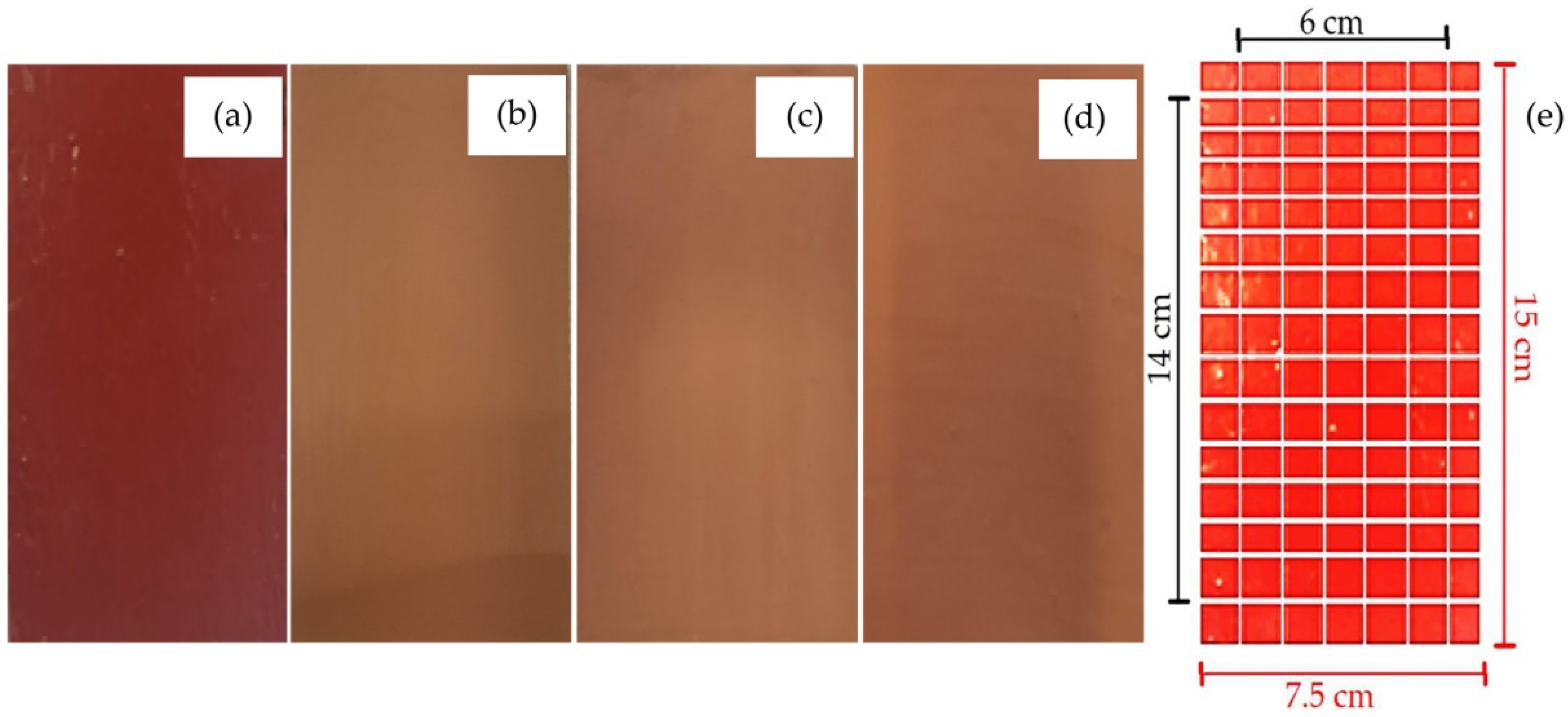
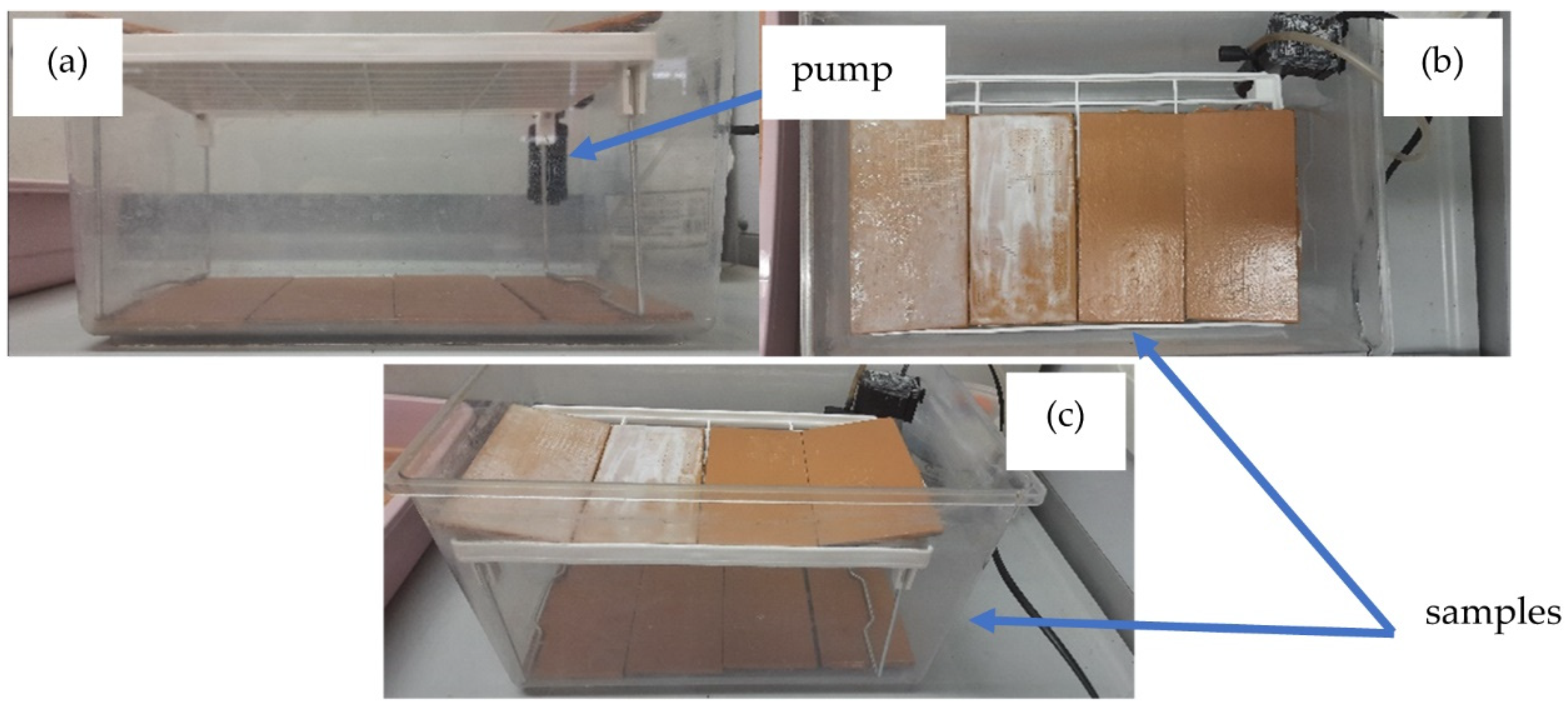
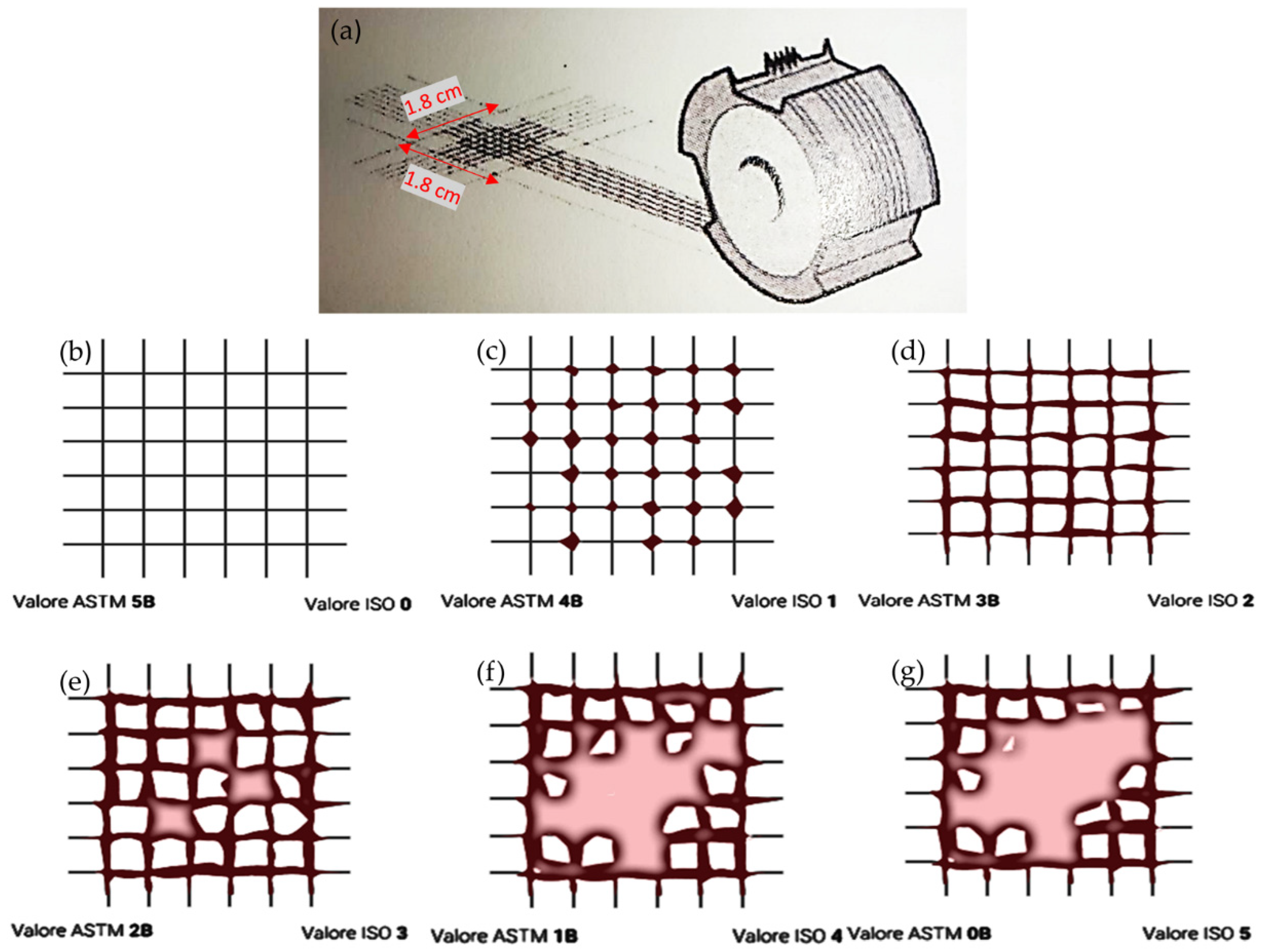

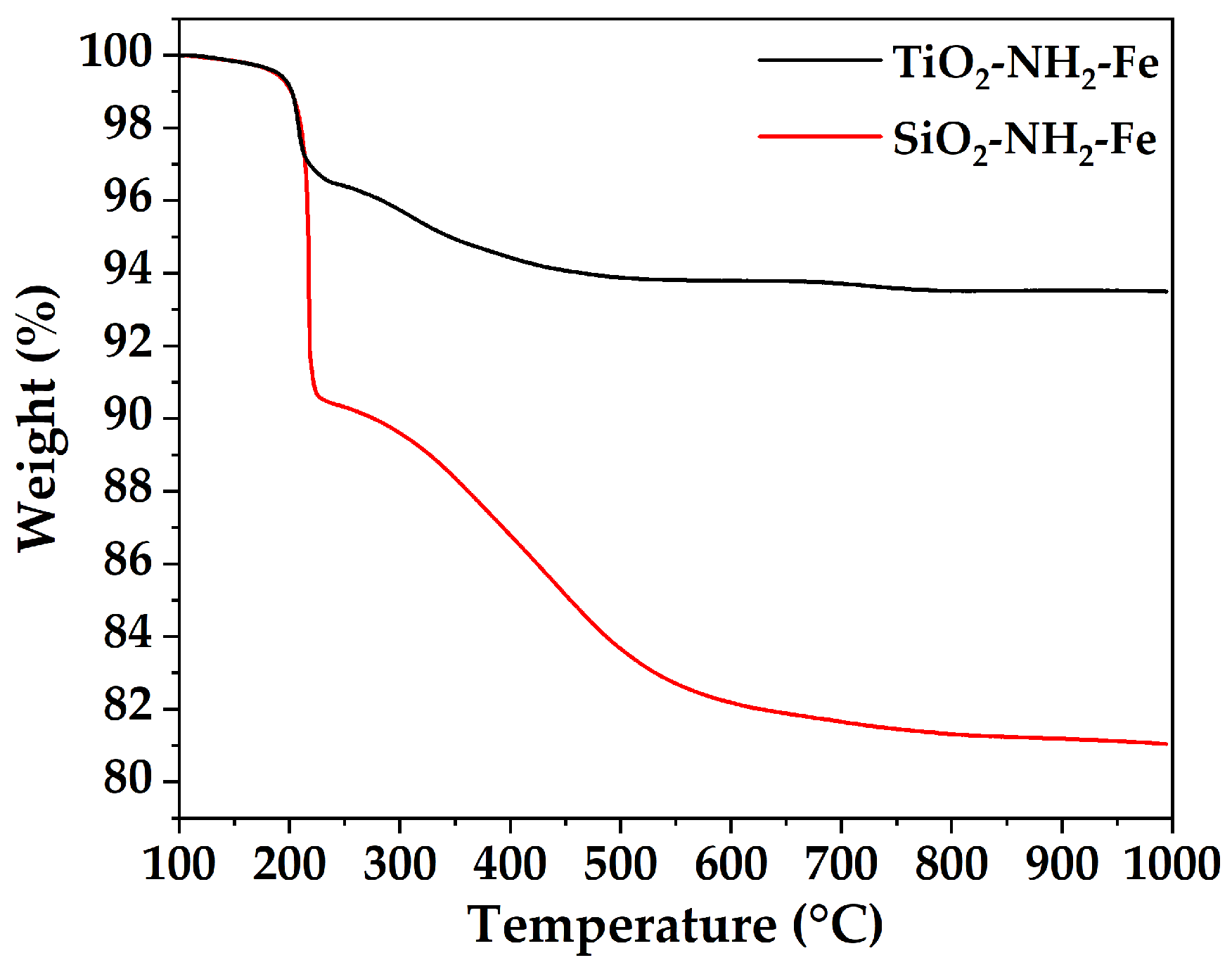

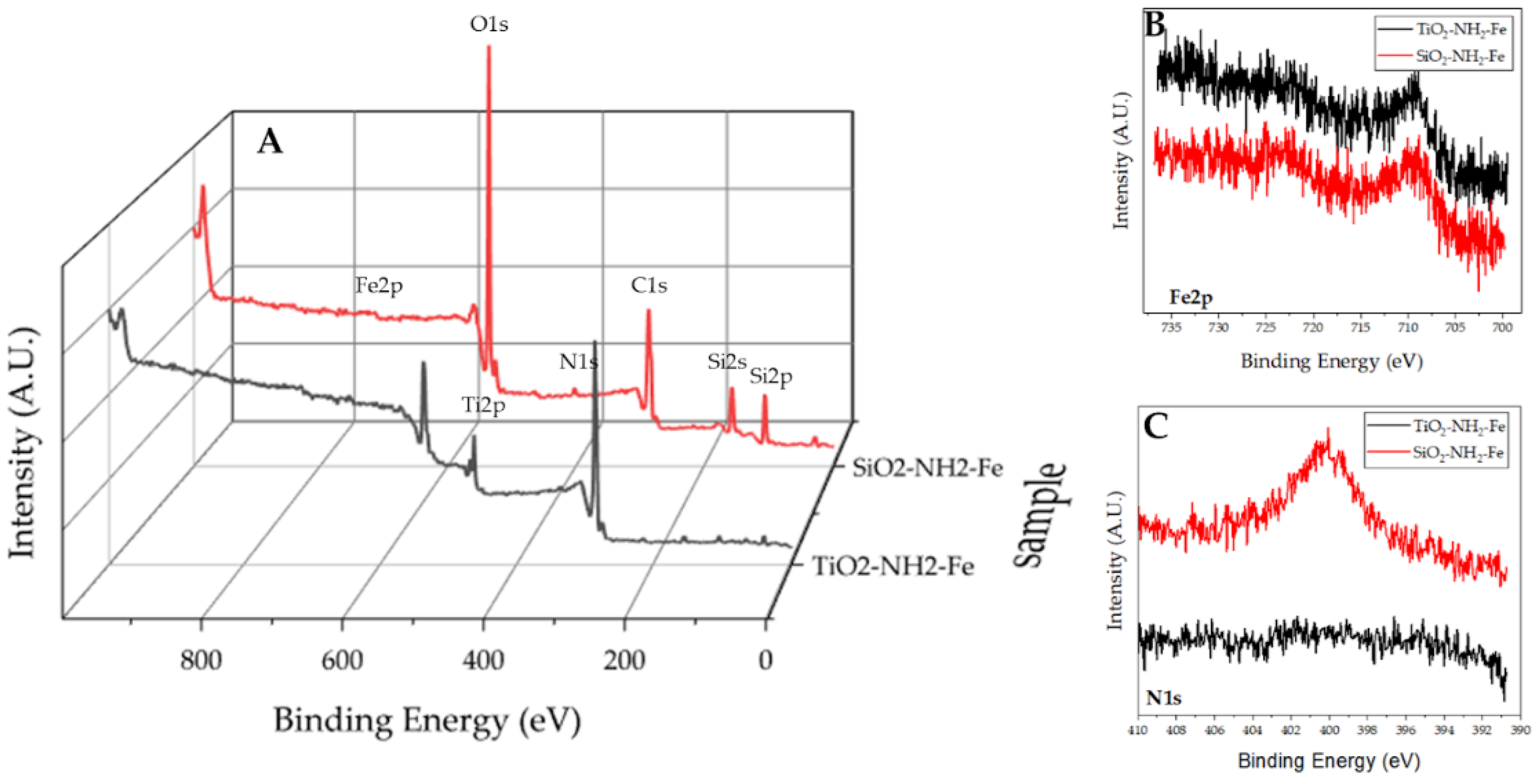
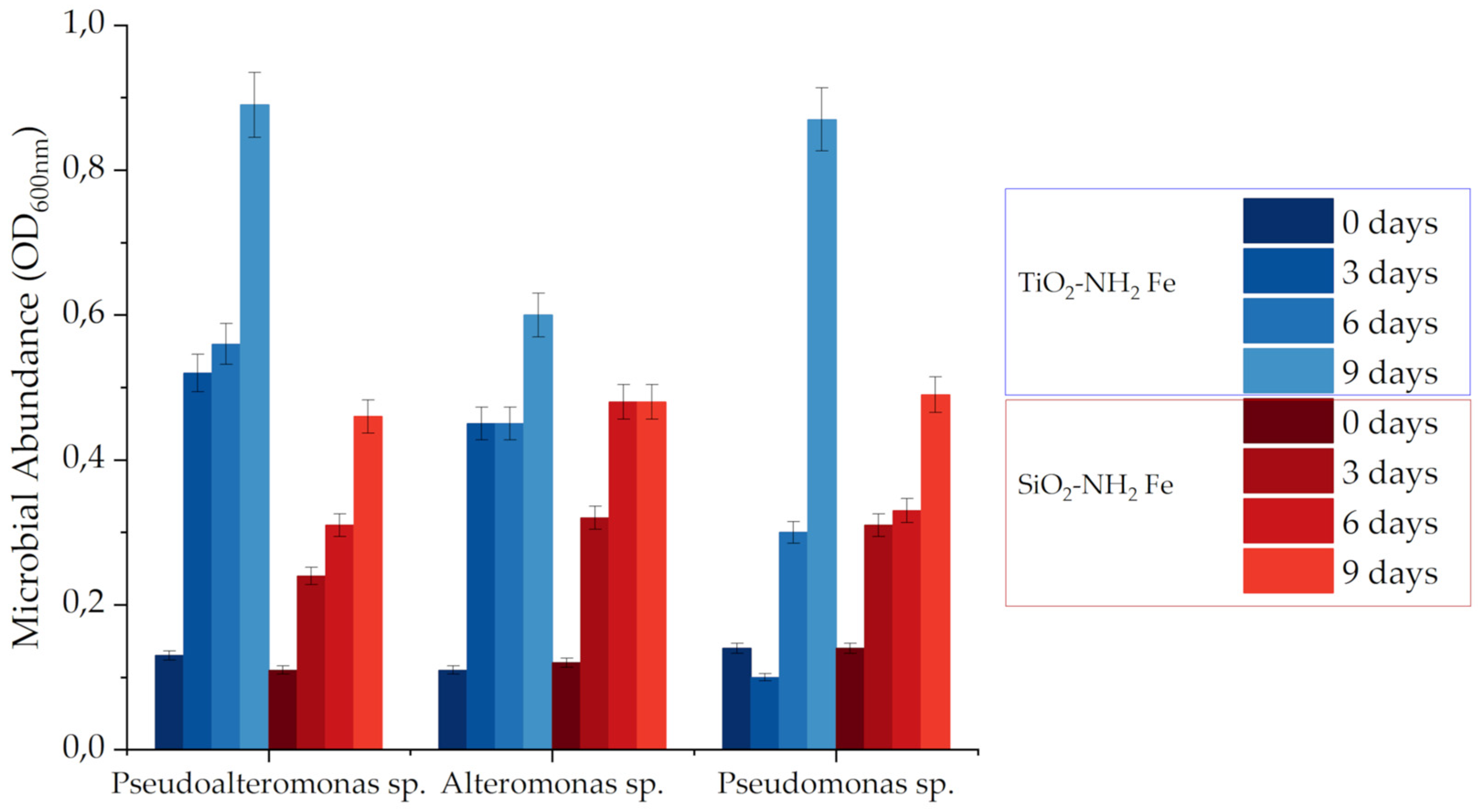
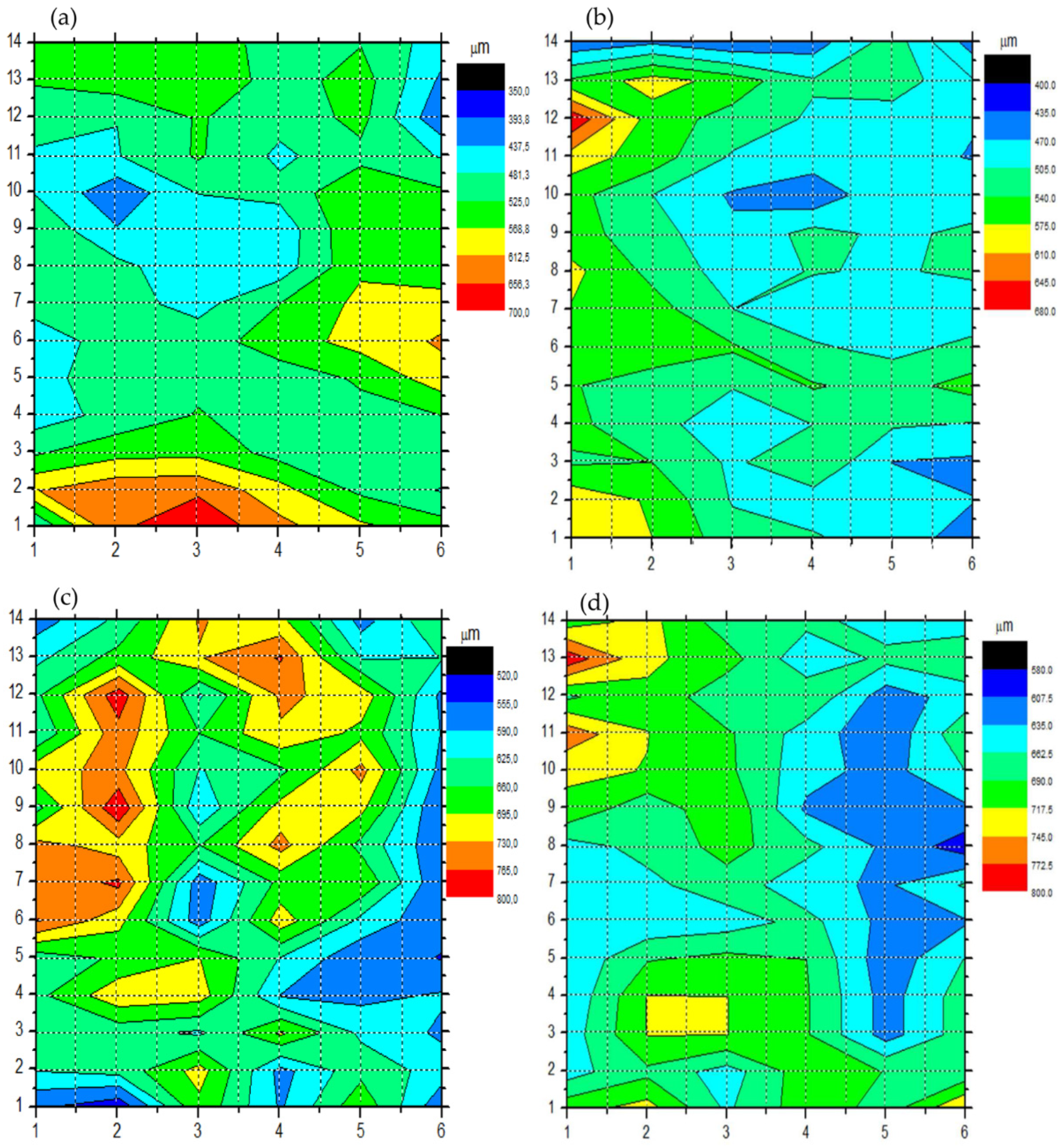
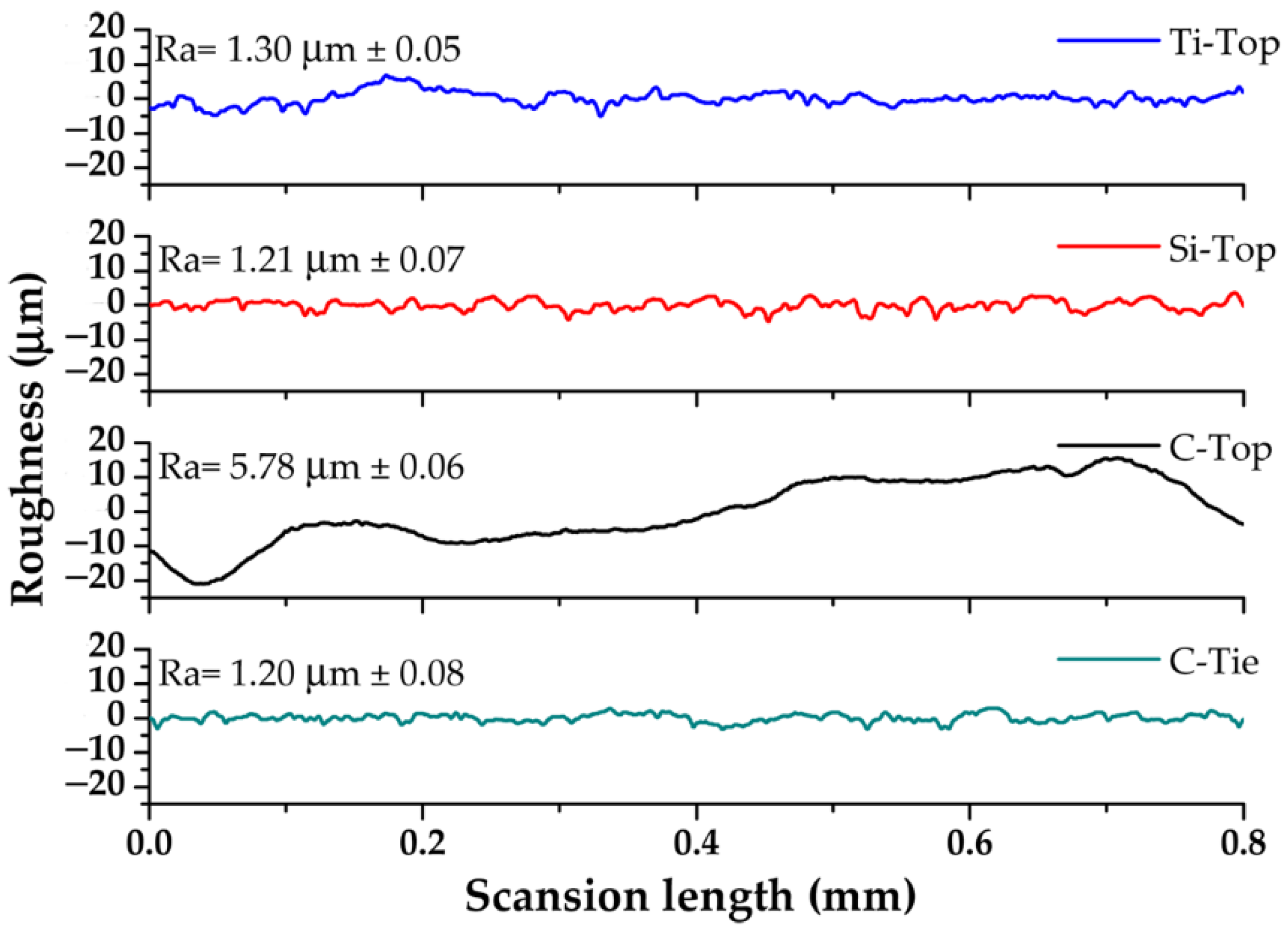
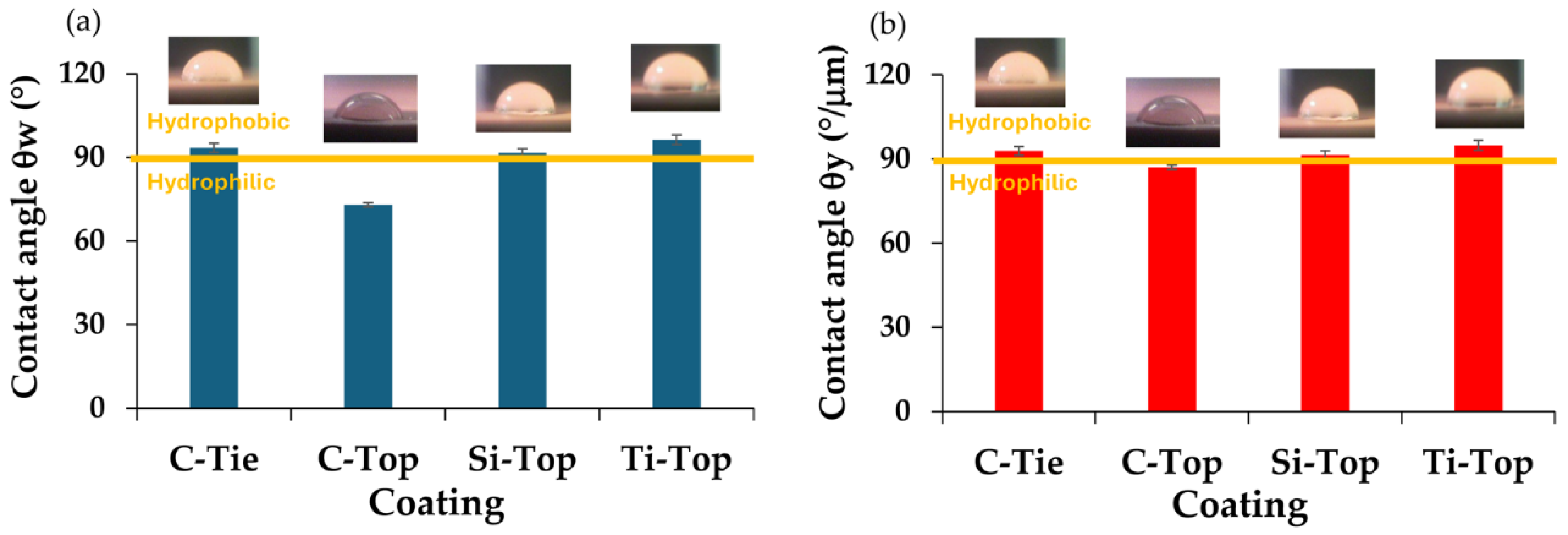
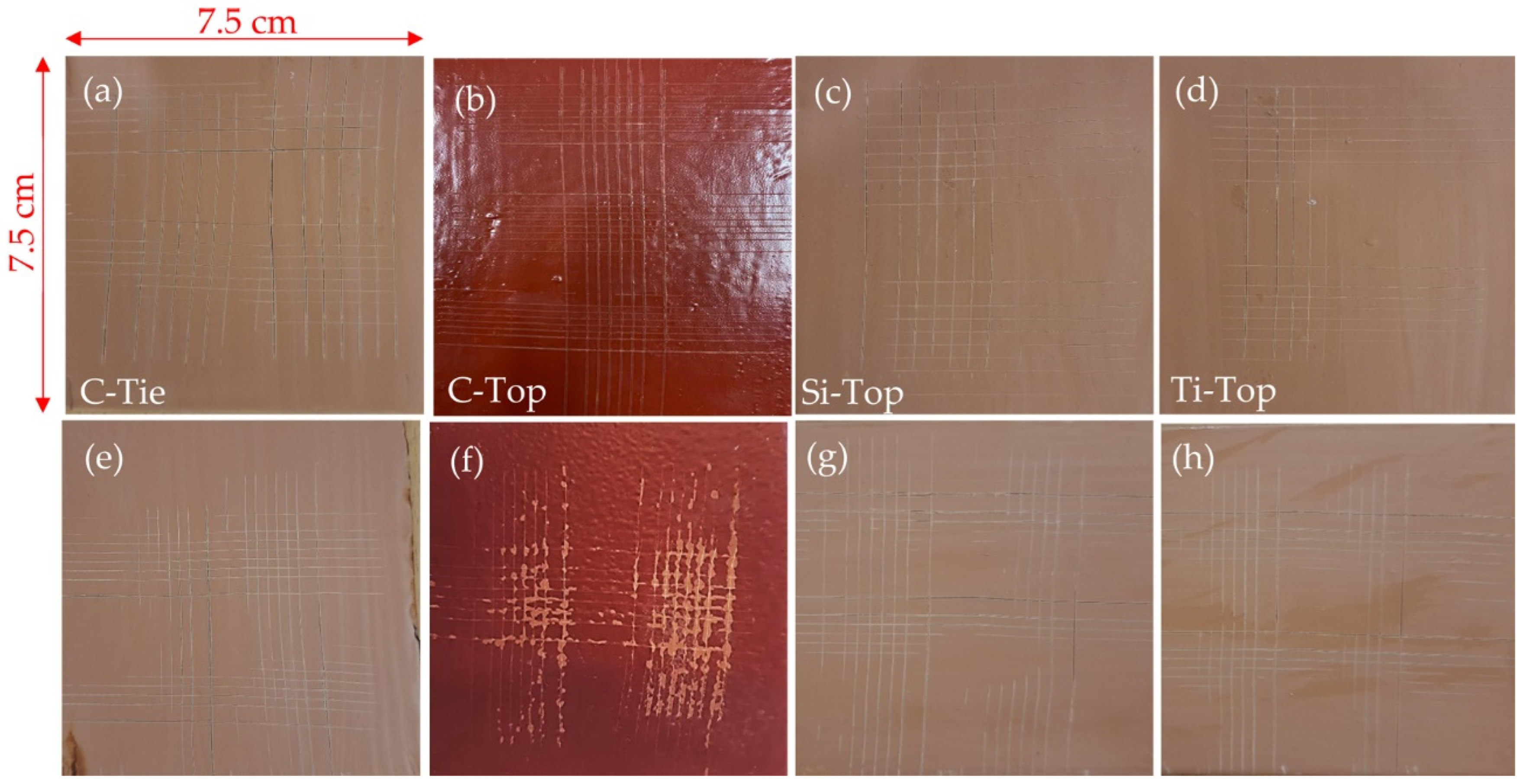
| C | Mn | Si | P | S | Al | Cb (Nb) | Ti | Cu | Cr | Ni | Mo | Ca | Fe |
|---|---|---|---|---|---|---|---|---|---|---|---|---|---|
| 0.18 | 0.9–0.16 | 0.1–0.5 | 0.035 | 0.035 | 0.015 | 0.02–0.05 | 0.02 | 0.35 | 0.20 | 0.40 | 0.08 | 0.05 | Bal. |
| Code | Typology of Material | Description | Details |
|---|---|---|---|
| C-Top | Sea Quantum Ultra S | Commercial topcoat | Cutting-edge, single-component antifouling with silyl acrylate chemical reaction |
| C-Tie | Safeguard Universal ES, Jotun “tie-coat” | Commercial tie coat | Two-component epoxy-vinyl with polyamide hardener (5:1) |
| Si-Top | Si-Tie + SiO2-NH2-Fe | Commercial Tiecoat + our SiO2-based additive | |
| Ti-Top | Ti-Tie + TiO2-NH2-Fe | Commercial Tiecoat + our TiO2-based additive |
| Sample | Concentration (mg L−1) | Matrix | EC50 mg L−1 (15’) | EC50 mg L−1 (30’) |
|---|---|---|---|---|
| SiO2-NH2-Fe | 100 | Powder | >100 | >100 |
| TiO2-NH2-Fe | 100 | Powder | >100 | >100 |
| Sample Code | Thickness [μm] | Wenzel/Roughness/Young Contact Angle | Cross-Cut Test ASTM D 3359-09e2/ISO2409:2007 | |||
|---|---|---|---|---|---|---|
| θw [°] | Ra [μm] | θy [°/μm] | (t = 0 days) | (t = 30 days) | ||
| C-Tie | 498 ± 96 | 93.47 ± 1.62 | 1.20 ± 0.08 | 92.89 ± 1.62 | 5B/0 | 4B/1 |
| C-Top | 515 ± 52 | 73.04 ± 0.73 | 5.78 ± 0.06 | 87.11 ± 0.73 | 5B/0 | 2B/3 |
| Si-Top | 653 ± 73 | 91.65 ± 1.58 | 1.21 ± 0.07 | 91.36 ± 1.58 | 5B/0 | 4B/1 |
| Ti-Top | 674 ± 64 | 96.37 ± 1.75 | 1.30 ± 0.05 | 94.90 ± 1.75 | 4B/1 | 3B/2 |
Disclaimer/Publisher’s Note: The statements, opinions and data contained in all publications are solely those of the individual author(s) and contributor(s) and not of MDPI and/or the editor(s). MDPI and/or the editor(s) disclaim responsibility for any injury to people or property resulting from any ideas, methods, instructions or products referred to in the content. |
© 2025 by the authors. Licensee MDPI, Basel, Switzerland. This article is an open access article distributed under the terms and conditions of the Creative Commons Attribution (CC BY) license (https://creativecommons.org/licenses/by/4.0/).
Share and Cite
Testa, M.L.; Calabrese, C.; La Parola, V.; Scolaro, C.; Visco, A.; Cappello, S.; Liotta, L.F. Surface Properties of Coatings Based on Iron Amino-Functionalized Oxides Deposited on DH 36 Steel Plates for Shipbuilding. Nanomaterials 2025, 15, 150. https://doi.org/10.3390/nano15030150
Testa ML, Calabrese C, La Parola V, Scolaro C, Visco A, Cappello S, Liotta LF. Surface Properties of Coatings Based on Iron Amino-Functionalized Oxides Deposited on DH 36 Steel Plates for Shipbuilding. Nanomaterials. 2025; 15(3):150. https://doi.org/10.3390/nano15030150
Chicago/Turabian StyleTesta, Maria Luisa, Carla Calabrese, Valeria La Parola, Cristina Scolaro, Annamaria Visco, Simone Cappello, and Leonarda Francesca Liotta. 2025. "Surface Properties of Coatings Based on Iron Amino-Functionalized Oxides Deposited on DH 36 Steel Plates for Shipbuilding" Nanomaterials 15, no. 3: 150. https://doi.org/10.3390/nano15030150
APA StyleTesta, M. L., Calabrese, C., La Parola, V., Scolaro, C., Visco, A., Cappello, S., & Liotta, L. F. (2025). Surface Properties of Coatings Based on Iron Amino-Functionalized Oxides Deposited on DH 36 Steel Plates for Shipbuilding. Nanomaterials, 15(3), 150. https://doi.org/10.3390/nano15030150












